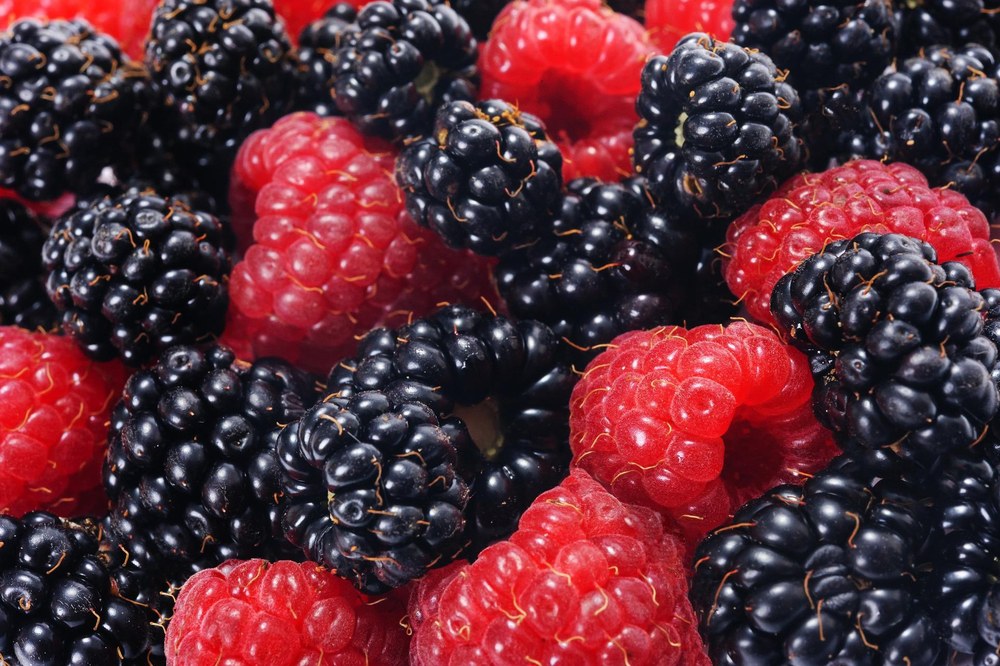Posted: June 6, 2022
Generally, most edible fruits are easy to identify in nature like apples, pears, and grapes. Others aren’t so easy, for example what’s the difference between a blackberry and a raspberry?

Raspberries and Blackberries (Pixaby.com)
I have always enjoyed picking fresh fruit from the great outdoors. Besides tasting good I guess it gives me a sense of living off the land and being able to identify what is safe to eat. If we are fortunate enough to be able to enjoy nature's bounty then learning a little more about what we are eating can't hurt, right?
You may assume the main difference between a raspberry and a blackberry is the color. That's what I thought. Well guess what? We are both wrong. For example, blackberries are red when they are unripe and the two main types of raspberries are both red and black. Confused? For many black raspberries are easily confused with blackberries. So how can you tell them apart? First, let's learn a little about these brambles.
According to botanists a bramble is sort of a compromise between a perennial herb and a shrub. The stems of both raspberry and blackberry are woody but instead of living from year to year and bearing an indefinite number of berry crops, they live about 1 ½ years and die back to the ground after their fruit matures. But guess what? Their roots live on indefinitely under the right conditions and they send up new shoots each spring. In other words, brambles have perennial roots with shoots that are biennial.
In the Northern Tier of Pennsylvania there are three main types of brambles that grow in the wild, red Raspberry (Rubus idaeus), Black raspberry (Rubus occidentalis), and blackberry (Rubus allegheniensis). The fruits of each are well sought after by berry picking enthusiasts. Each type has its own unique taste, growth habit, and, for many, secret location.
The best way to tell them apart is to look for the receptacle. The receptacle is the fleshy center core that the berry grows around. Both raspberries and blackberries produce aggregate fruits (several ovaries are found on a single flower). Raspberries and blackberries are composed of single-seeded drupelets held together by microscopic hairs around the receptacle. When you pick a raspberry, the receptacle gets left behind which causes the raspberry to have a cup-shaped cavity in the center. However, when you pick a blackberry, the receptacle stays with the fruit leaving a spongy white center in the blackberry. Also, the stem that is left behind on the blackberry bush is clean or flat. Another characteristic although somewhat harder to identify is that blackberry fruits tend to be more oblong and raspberries are more rounded.
What if there are no fruits on them? Both have canes or long stems coming out of the ground although blackberries tend to be taller than raspberries; when you take a closer look at blackberry canes, they are purplish-red with well stout, straight broad based thorns, depending on the cultivar. Yes, they hurt and they are painful to walk through. Black raspberries have scattered smaller hooked thorns. The canes of black raspberry also have a whitish appearance. Red raspberries are usually bristly with few or no thorns. The canes on red raspberry are slightly whitish.
If you plan on picking berries this year, both the black and red raspberries tend to ripen in July. You can manipulate the timing of your red raspberry harvest with careful attention to when you prune. Blackberries tend to ripen a little later although there is some overlap between the species. All brambles are shade intolerant; they like full sun. In the wild, brambles are usually found in disturbed areas. A good place to look for them is along roadsides, heavily logged over woods, clearings, abandoned fields, and fencerows. Brambles will grow on all but the wettest soils. One of my favorite spots for picking blackberries is a forest that was heavily logged a few years back. The woods have several large openings, with lots of sunlight. Sadly, as time goes by the openings will diminish and those ideal conditions for growing brambles will too. If you have a favorite patch of brambles on your property and you would like to keep them around you may want to consider releasing them (daylighting) from competing vegetation to allow at least 6 hours of sunlight to reach them a day. It is not recommended for gardeners to transplant wild brambles into their garden because of the risk of disease that may pass onto nursery-bought plants.
If you decide to try growing raspberries and blackberries in your backyard, you are in luck--they are relatively easy to grow. Today there are a wide variety of raspberry and blackberry cultivars available, with each cultivar having its own unique growth habit, disease resistance, and fruiting time. Purple and gold raspberries are even available now. Producers also have several thornless varieties of brambles on the market today. I counted over 50 cultivars of blackberry and raspberry that can be grown in Pennsylvania alone.
Well, that's a lot to take in! But regardless of what you have learned about blackberries and raspberries always remember to enjoy the sweet juicy fruit they provide.
References
Plant Profile for Rubus idaues
(American Red Raspberry)
Plant Profile for Rubus fruticosis (blackberry)
Rubus idaues var. strigosus (American Raspberry)
North Carolina Agricultural and Environmental Sciences
Cooperative Extension
Blackberries for the Home Garden NC State Extension Publication
North Carolina Agricultural and Environmental Sciences
Blackberry I Diseases and Pests, Description, Uses, Propagation
Penn State University 201 Old Main, University Park, PA 16802

